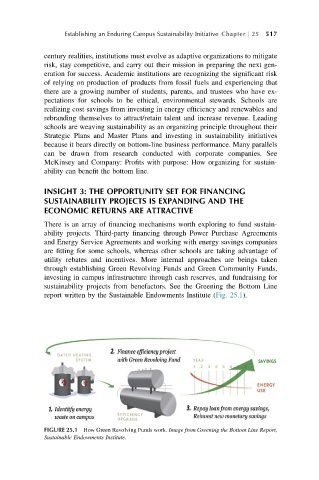Page 548 - Sustainable Cities and Communities Design Handbook
P. 548
Establishing an Enduring Campus Sustainability Initiative Chapter j 25 517
century realities, institutions must evolve as adaptive organizations to mitigate
risk, stay competitive, and carry out their mission in preparing the next gen-
eration for success. Academic institutions are recognizing the significant risk
of relying on production of products from fossil fuels and experiencing that
there are a growing number of students, parents, and trustees who have ex-
pectations for schools to be ethical, environmental stewards. Schools are
realizing cost savings from investing in energy efficiency and renewables and
rebranding themselves to attract/retain talent and increase revenue. Leading
schools are weaving sustainability as an organizing principle throughout their
Strategic Plans and Master Plans and investing in sustainability initiatives
because it bears directly on bottom-line business performance. Many parallels
can be drawn from research conducted with corporate companies. See
McKinsey and Company: Profits with purpose: How organizing for sustain-
ability can benefit the bottom line.
INSIGHT 3: THE OPPORTUNITY SET FOR FINANCING
SUSTAINABILITY PROJECTS IS EXPANDING AND THE
ECONOMIC RETURNS ARE ATTRACTIVE
There is an array of financing mechanisms worth exploring to fund sustain-
ability projects. Third-party financing through Power Purchase Agreements
and Energy Service Agreements and working with energy savings companies
are fitting for some schools, whereas other schools are taking advantage of
utility rebates and incentives. More internal approaches are beings taken
through establishing Green Revolving Funds and Green Community Funds,
investing in campus infrastructure through cash reserves, and fundraising for
sustainability projects from benefactors. See the Greening the Bottom Line
report written by the Sustainable Endowments Institute (Fig. 25.1).
FIGURE 25.1 How Green Revolving Funds work. Image from Greening the Bottom Line Report,
Sustainable Endowments Institute.

